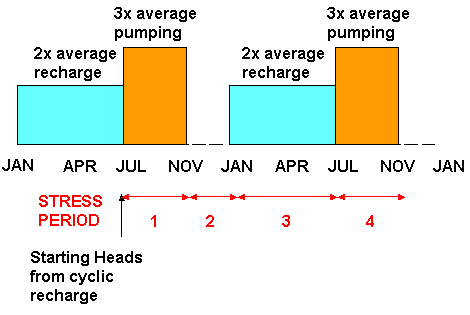Start at the end of a "wet" period, the end of June
Define 4 stress periods:
- Jul-Oct (4mo) = no recharge,
pumping
- Nov-Dec (2mo) = no recharge, no pumping
- Jan-Jun (6mo) = high recharge, no pumping
- Jul-Oct (4mo) = no recharge, pumping
- Nov-Dec (2mo) = no recharge, no pumping

1. Save ex7a in a directory ex7b as ex7b.gwv use a root file name of extr7b
- Confirm that the paths to models are correct
- Model>MODFLOW>BasicPackage
- Specify 4 stress periods
- Model>MODFLOW>StressPeriodSetup
- Jul-Oct = (4mo) 1.0512x107
sec
- Nov-Dec = (2mo) 5.256x106 sec
- Jan-Jun = (6mo) 1.5768x107 sec
- Jul-Oct = (4mo) 1.0512x107 sec
- use 10 steps each and multiplier of 1.1
- Nov-Dec = (2mo) 5.256x106 sec
- Model>MODFLOW>InitialHeads
- Select extr7.hds from ex7a
- stress period 29, time step 10
- Model>MODFLOW>Output Control Package
- Save heads every tenth time step to have them at the end of each stress period
- uncheck the Disable printing box
- print all relevant items for your problem
- With Edit mode set for properties
- Step through the stress periods and set the RCH for the zone near the river as 4x10-8 and the zone away from the river as 2x10-8 for period 3; all other recharges should be zero
- With Edit mode set for BC
- Replace the wells in each layer and set transient pumping rates at 3cms for stress periods 1 and 4
Notice that you need to uncheck steady state and select Transient Data to input stress period 1 to1, -3; 2 to 3, 0; and 4 to 4 -3
- Remember to include the well package in the model
- GHBs and RIVs need not be considered because the default is that boundary conditions are steady unless specified otherwise
- Step through the stress periods and set the RCH for the zone near the river as 4x10-8 and the zone away from the river as 2x10-8 for period 3; all other recharges should be zero
-
Create MODFLOW files
- View the new bas, wel, rch, and oc files
- Execute MODFLOW
- View results by comparing profiles in row 9 and model budget summaries at the end of each stress period
- FIRST! Check the recharge and well files to see how they have changed
Also: Peruse the MODFLOW output file, looking for conditions that you do not expect - View the new bas, wel, rch, and oc files
Look at the Model Mass Balances and Head Profiles along row 9 at the end of each stress period: